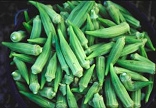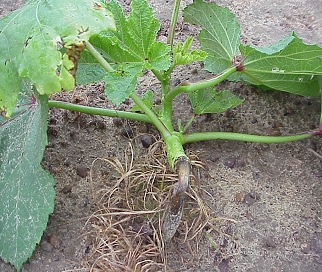Weeds left uncontrolled in okra can result in significant yield loss (Adejonwo et al. 1987, 1991). Being related to cotton, okra can be a poor competitor with weeds, particularly early in the growing season.
Additionally, as the crop is harvested and leaves are removed from the plant, more sunlight can reach the soil and increase late-season weed interference. Because okra will continue to produce fruit until a killing frost occurs, this late-season interference can be substantial.
Research has found the critical weed-free period, the period during which there is no loss of yield if weeds are kept out, for many crops (Nieto et al., 1968; Roberts, 1976). Research in okra has shown that no weed-free period occurs (Iremiren 1988). Few herbicides are registered for use in okra. Therefore, okra production still heavily depends on cultivation and hand weeding to preserve high yields.
Cultivation Options in Okra
Shallow cultivation can help to control weeds after they emerge between crop rows. Cultivate along the row middles between crop rows.
Cultivation is most effective for weed control when properly timed. Cultivating too early could lessen the benefits of any preemergence herbicides. Weeds may be too large to kill with shallow cultivation, however, if cultivation occurs too late.
Hand hoeing within crop rows should begin as soon as weeds emerge.
Herbicide Options in Okra
Herbicide Options in Okra
Preplant and Preemergence
Glyphosate (Roundup and other trade names) may be applied prior to crop emergence with the goal of killing emerged weeds. It will nonselectively kill these weeds and will translocate in the plant to help control large weeds as well as perennials. Apply at a rate of 0.5 to 1.5 pounds of active ingredient per acre. Rate of product per acre will change based on the particular formulation being used. Perennial weeds may require higher rates of glyphosate. Add surfactant to brands of glyphosate requiring surfactant in accordance with the product label.
Trifluralin (Treflan 4EC and other names) is labeled for preplant-incorporated use in okra for control of annual grasses and small-seeded broadleaf weeds. Application rates range from 0.5 to 1 pound of active ingredient per acre (1 to 2 pints per acre). For maximum activity, the preplant application needs to be incorporated 2 to 3 inches deep within 24 hours of application.
NOTE: Metolachlor (Dual) has previously been labeled for use preplant-incorporated or preemergence in okra. This label was in place when the U.S. Environmental Protection Agency (EPA) categorized okra with pod crops, such as peas and beans. When this classification was changed in the mid-1990s, the use of metolachlor in okra was discontinued and remains prohibited.
Postemergence
Glyphosate (Roundup WeatherMax 5.5L) may be applied as a hooded or shielded spray or wiper application to row middles between crop rows or as a post-harvest nonselective spray. Make every effort to avoid contact of glyphosate with the crop. Apply at 0.5 to 0.94 pound of active ingredient per acre or 11 to 22 ounces of product per acre. Surfactant is not needed with this brand of glyphosate. Do not apply within 14 days of harvest.
Carfentrazone (Aim 1.9 EW, 2.0 EC) may be applied to small, emerged weeds in okra as a hooded or shielded application to row middles between crop rows. Up to 2 ounces per acre may be applied at any one application, with a seasonal limit of 6.1 ounces per acre for okra. Contact with okra foliage during an application may result in crop injury (see Figure 1 and Figure 2).
Good weed coverage with Aim is essential, and it is recommended that a crop oil concentrate (1 percent of spray volume) or nonionic surfactant (0.25 percent of spray volume) be used.
Sethoxydim (Poast 1.5 EC) can be applied postemergence to okra to control emerged grass species. Apply 1.5 pints of product per acre with a seasonal maximum of 5.5 pints per acre. Do not apply within 14 days of harvest. Sethoxydim will not control nutsedge, broadleaf weeds, or grasses that have yet to emerge.
Recent Findings
Prometryn (Caparol 4 L, Cotton-Pro 4 L) use in okra has been investigated in recent years. Replicated trials in North Carolina and Georgia showed that Cotton-Pro applied pre- or post-emergence at 1.5 pints per acre did not cause significant injury to okra (Batts & Culpepper, unpublished data). Registration of prometryn is currently being pursued through the USDA IR-4 program, with data submission to the U.S. EPA expected in summer 2008.
Recommended Weed Management Program
Preplant: Glyphosate
Preplant incorporated: Trifluralin
Postemergence: Cultivation and hand-hoeing in combination with glyphosate or carfentrazone, or a combination of both, applied to row middles between crop rows. Poast for annual grasses.
Literature
Adejonwo, K. O., D. D. Mamtso, and S. T. O. Lagoke. 1987. Evaluation of pre- and directed post-emergence herbicide mixtures for weed control in okra. Tests of Agrochemicals and Cultivars, Annals of Applied Biology, 110 Suppl.:92-93.
Adejonwo, K. O., M. K. Ahmad, S. T. O. Lagoke, and S. K. Karikari. 1991. Chemical weed control in irrigated okra in the Nigerian Sudan savanna zone. Tropical Pest Management. 37:91-95.
Iremiren, G. O. 1988. Frequency of weeding okra (Abelmoschus esculentus) for optimum growth and yield. Experimental Agric. 24:247-252.
Nieto, H. J., M. A. Bernardo, and J. T. Gonzalez. 1968. Critical periods for the crop growth cycle for competition from weeds. PANS 14:159-166.
Roberts, H. A. 1976. Weed competition in vegetable crops. Annals of Applied Biology 83:321-324.
Always read and understand the entire label prior to using any herbicide.
Prepared by
Roger B. Batts, David W. Monks, Wayne E. Mitchem, and Katie M. Jennings
Department of Horticultural Science
Publication date: Jan. 1, 2008
Reviewed/Revised: Jan. 30, 2024
AG-700-04
Recommendations for the use of agricultural chemicals are included in this publication as a convenience to the reader. The use of brand names and any mention or listing of commercial products or services in this publication does not imply endorsement by NC State University or N.C. A&T State University nor discrimination against similar products or services not mentioned. Individuals who use agricultural chemicals are responsible for ensuring that the intended use complies with current regulations and conforms to the product label. Be sure to obtain current information about usage regulations and examine a current product label before applying any chemical. For assistance, contact your local N.C. Cooperative Extension county center.
N.C. Cooperative Extension prohibits discrimination and harassment regardless of age, color, disability, family and marital status, gender identity, national origin, political beliefs, race, religion, sex (including pregnancy), sexual orientation and veteran status.




